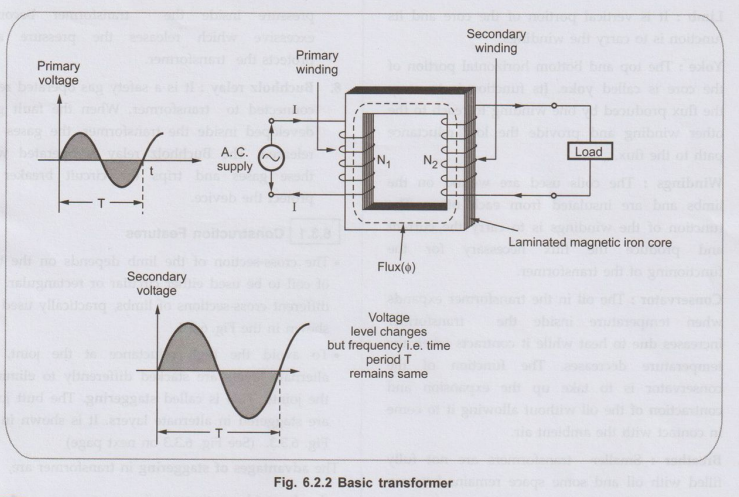Electrical Machines: Unit IV: Single Phase Transformer
Working Principle of Single Phase Transformer
The principle of mutual induction states that when two coils are inductively coupled and if current in one coil is changed uniformly then an e.m.f. gets induced in the other coil.
Principle
of Working
AU: Dec.-13,17, May-13,14.
The
principle of mutual induction states that when two coils are inductively
coupled and if current in one coil is changed uniformly then an e.m.f. gets
induced in the other coil. This e.m.f. can drive a current, when a closed path
is provided to it. The transformer works on the same principle. In its
elementary form, it consists of two inductive coils which are electrically
separated but linked through a common magnetic circuit. The two coils have high
mutual inductance. The basic transformer is shown in the Fig. 6.1.1.

•
One of the two coils is connected to a source of alternating voltage. This coil
in which electrical energy is fed with the help of source is called primary
winding (P). The other winding is connected to load. The electrical energy
transformed to this winding is drawn out to the load.
•
This winding is called secondary winding (S). The primary winding has N1
number of turns while the secondary winding has N2 number of turns.
Symbolically the transformer is indicated as shown in the Fig. 6.2.1.

•
When primary winding is excited by an alternating voltage, it circulates an
alternating current. This current produces an alternating flux (ϕ) which
completes its path through common magnetic core as shown dotted in the Fig.
6.2.2. Thus an alternating, flux links with the secondary winding. As the flux
is alternating, according to Faraday's law of an electromagnetic induction,
mutually induced e.m.f. gets developed in the secondary winding. If now load is
connected to the secondary winding, this e.m.f. drives a current through it.
• Thus though there is no electrical contact between the two windings, an electrical energy gets transferred from primary to the secondary.

Key Point:
The frequency of the mutually induced e.m.f. is same as that of the alternating
source which is supplying energy to the primary winding.
1. Can D.C. Supply be used for Transformers?
•
The d.c. supply cannot be used for the transformers.
•.
The transformer works on the principle of mutual induction, for which current
in one coil must change uniformly. If d.c. supply is given, the current will
not change due to constant supply and transformer will not work.
•
Practically winding resistance is very small. For d.c., the inductive reactance
XL is zero as d.c. has no frequency. So total impedance of winding
is very low for d.c. Thus winding will draw very high current if d.c. supply is
given to it. This may cause the burning of windings due to extra heat generated
and may cause permanent damage to the transformer.
•
There can be saturation of the core due to which transformer draws very large
current from the supply when connected to d.c.
Thus
d.c. supply should not be connected to the transformers.
Review Question
1. Explain the
working principle of a single phase transformer.
AU: Dec.-13,17,
May-13, 14, Marks 8
Electrical Machines: Unit IV: Single Phase Transformer : Tag: : - Working Principle of Single Phase Transformer
Related Topics
Related Subjects
Electrical Machines I
EE3303 EM 1 3rd Semester EEE Dept | 2021 Regulation | 3rd Semester EEE Dept 2021 Regulation
